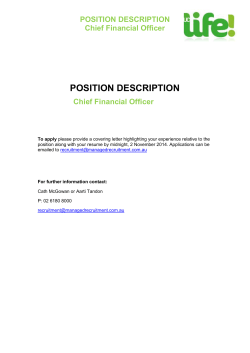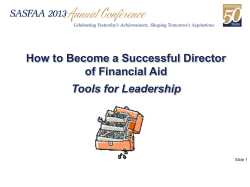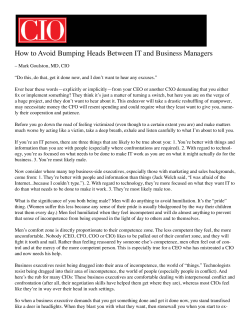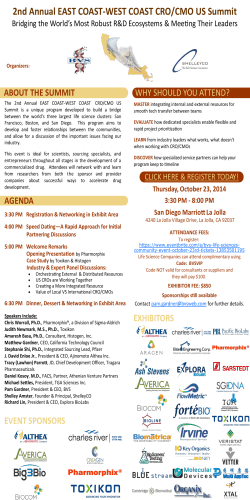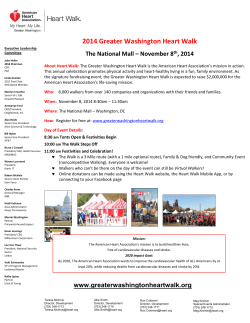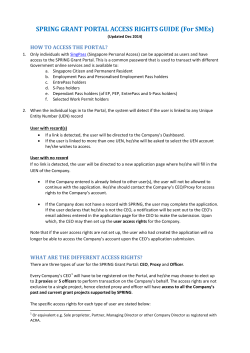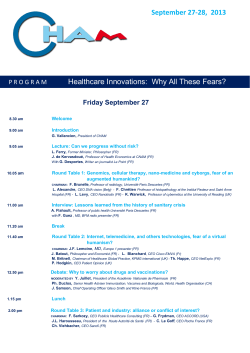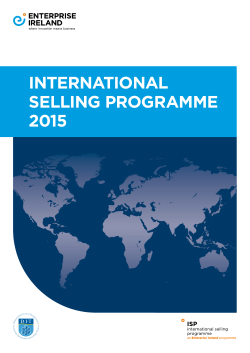
Do CEO Personal Traits, Skills and Experiences Trigger the
RESEARCH TOPIC: CEO Personal Traits, Skills and Experiences and Managerial Overconfidence Presented By: Josephine Yau DURHAM UNIVERSITY BUSINESS SCHOOL Background of study Focus area: Behavioural Finance- Managerial Overconfidence (MO) In conventional finance theories, with all the information available, a manager will be assumed to act rationally when making investment decisions (Vasile et al., 2012). Despite from the traditional paradigm, experimental psychology reports that people tend to be extremely overconfidence and optimism which they believe they have more knowledge about future event and they also tend to predict better outcome than actual (Hackbarth, 2008). In real business world, the decisions made by manager are different based on individual’s sentiments. As mentioned by Graham et al. (2013), firms in the same country, same industry, similar size and having similar investment opportunities behave differently. In this study, derived from management and leadership theory, the important of manager personal attributes in managing a firm will be explicitly examined by looking at how chief executive officers (CEOs)’ personal traits, skill and experiences may influence their overconfidence behaviour. Scope of study: 236 CEOs from the UK FTSE100 firms (year 2000-2013) Research Questions What drives CEOs to exhibit overconfident behaviour in corporations? Existing literature mainly debates whether an overconfident CEO’s behaviour destroys or enhances a firm’s value; however, there is little research which provides insight into the causes of CEO overconfidence as mentioned by Petit and Bollaert (2012). Although previous studies confirmed the importance of leader’s attributes in managing a firm (e.g., Yukl, 1982, 1989; Zaccaro, 2007), the relationship of a CEO’s personal traits, skills and experiences with his or her overconfident behaviour are relatively unexplored. Therefore, a research question remains unsolved in the literature : to what extent do personal attributes vary among overconfident and non-overconfident CEOs? In particular, this study investigates 236 CEOs in UK FTSE 100 firms between year 2000-2013 and aims to address the following questions: 1. Do CEOs’ personal traits (e.g., age, gender, nationality, and marital status) have a relationship with their overconfident behaviour? 2. Do CEOs’ skills and experiences (e.g., power, internal networking, and external networking) affect their overconfident behaviour? Objectives of the Study A better understanding of the issue of managerial overconfidence (MO) in a corporation can enhance the firm value and hence benefit shareholders’ welfare (Hirshleifer, Low & Teoh, 2012). Unlike many studies, which examine the corporate decisions made by overconfident managers, this study investigates the potential factors that may drive CEOs to become overconfident. Therefore, this study aims to: 1. Identify the personal traits (gender, age, nationality, and marital status) of a CEO that may contribute to his/her overconfidence behaviour. 2. Identify the skills and experiences (power, internal networking and external networking) of a CEO that may be associated with his/her overconfident behaviour. 3. Propose composite indexes of CEO Traits (TI), CEO Skills and Experiences (SEI) that can explain the overconfident manager’s behaviour. 4. Provide an additional insight into the underlying factors of a CEO’s overconfident behaviour from the perspective of a CEO’s personal attributes, firm and macroeconomic effects. Contribution and Gap in the Literature 1. There is are few studies which specifically investigates CEO personal traits, skills and experiences and how these personal attributes may contribute to their overconfident behaviour. Only one relevant paper by Ben-David, Graham and Harvey (2007) study on determinant of managerial overconfidence of the US Chief Financial Officers (CFOs). 2. This study attempts to investigate research gap by using primary unique datasets, which are hand collected. The CEOs’ traits, skills and experiences are assessed from the data and information disclosed publicly from various sources. 3. Propose two modified proxies of managerial overconfidence, which allow time variation to capture the changes in CEOs’ behaviour. 4. New composite indexes of CEO personal Trait Index (TI) and Skills and Experiences Index (SEI). TI and SEI may be used as an additional variable in explaining managerial behaviour. SEI index may be used as a competency comparison among skills and experiences of CEOs ( assessing existing CEO and recruiting new CEO) 5. As mentioned by Mohamed, Baccar, Fairchild and Bouri (2012) there is no well-established theoretical framework which explicitly expresses the link between CEO personal attributes toward their optimistic behaviour. The integration of the leadership approaches; This is the first attempt to examine CEOs’ personal attributes, which derive from management perspectives, and the effect on managerial overconfident behaviour. Significance and Implications 1. Provides an insight into managerial overconfidence froma CEO personal perspective, firm characteristics and macroeconomic conditions. Although the existing literature finds that overconfident managers are more likely to destroy rather than to enhance firm value. Nevertheless, we suggest that certain industries may need overconfident CEOs to help the firm in gaining more investment opportunities. As suggested by Banerjee et al (2014), large and low-risk firms tend to appoint overconfident CEOs and these appointments are associated with improved performance. 2. Detecting the overconfident CEO is crucial in maintaining the sustainability and continuous success of the firm, as the CEO is the decision-maker of the firm. If they can be identified, the board can develop corporate governance mechanisms. 3. As suggested by previous research overconfident CEOs tend to take on more risky projects (e.g., Doukas & Petmezas, 2007; Fracassi & Tate, 2012; Malmendier & Tate, 2005a, 2005b) and higher risk projects will increase the variability of profits. This study provides useful information to investors, market participants and shareholder for their investment strategy. Knowing the characteristics of the overconfident CEO can help investors to properly plan for their investment, portfolio allocation and risk management. Research design Management & Leadership approaches • • • • Traits approach Power-influence Approach Social Exchange Theory Networking Behavioural Approach CEO Personal Traits Skill & Experiences Traits Index Skill and Experiences Index (SEI) • Power Index • Internal Networking Index • External Networking Index Managerial Overconfidence Behavior Proxy • Stock option • M&A • Insider Transaction I and II Managerial Overconfidence (M&A, SO, IT) Data & Methodology Unique dataset- hand collected 1. CEO Biography – Age, Gender, Nationality, Marital Status, MBA, PHD, 2. Founder, Financial Literacy, Duality, CEO Tenure, Emoluments, Tenure with the Firm, Internal Promotion, External Directorships, Social Networking Board Size and no of Independent Directors 3. Stock option exercise behavior SOURCES: Annual reports (Thomson Research Database, company website, Northcote website, and request from the firm) Lexis-Nexis database Standard & Poor's Register of Directors and Executives Who's Who MediaMarketing GmbH. Who's Who In European Business and Industry The Who's Who of Company Directors Marquis Who's Who LLC. The Complete Marquis Who's Who (R) Biographies Content5 Persons (English) Reed Elsevier Inc.: Who's Who In International Banking Debrett's People of Today US Executive Compensation Database - Executive Biographies Data & Methodology Secondary data Thomson DataStream database Firm and macroeconomics data Thomson ONE banker database Merger and Acquisitions transactions data Thomson ONE Ownership database Individual Insider Transactions data Data & Methodology Modified managerial Overconfidence (MO) proxy ◦ Allow the CEOs’ behavior change over time (stock option & insider transactions II) MO Proxies Stock Option exercise behaviour Insider Transactions II origin Malmendier and Tate (2005a), Croci et al. Malmendier and Tate (2005a) (2010) • Use first 5 years, if the CEO was a net buyer of stock more years • Who holds an option until the last than he was a net seller- “overconfidence” year of its duration- “overconfidence” • If CEO work more than 10 years, then their net buyer behaviour will be observed starting from year 6th. modify CEO will be classified as “Overconfidence”, “non-overconfidence” and “NA” based on his/her exercise behavior in the respective year. CEO will be classified as “overconfidence” if he was a net buyer in the respective year and “non-overconfidence” if he is the net seller in the particular year. ◦ Rationale: more sensible for a person to change their behavior as their personal traits, skill and experiences and the environment do change over time. Hypothesis Development 1. MO and CEO Personal Traits Hypothesis 2. MO and CEO Skills and Experiences Hypothesis 3. MO and Firm and Macroeconomic Conditions Hypothesis Hypothesis 1: Managerial Overconfidence and CEO Personal Traits Hypothesis Trait Approach H1a: H1b: H1c: H1d: Proxy measurement Expected relationship 1. 2. 3. 4. Negative Positive Positive positive Age Gender Nationality Marital status CEO’s age has a significant negative relationship with his/her overconfident behavioural Male CEO has a significant positive relationship with his overconfident behavioural The UK nationality CEO has a significant positive relationship with his/her overconfident behavioural CEO Marital Status has a significant positive relationship with his/her overconfident behavioural Hypothesis 1: Managerial Overconfidence and CEO Personal Traits Hypothesis (1a) 1. Age Graham, Harvey and Puri, (2013) mention that younger CEOs are more confidence and more risk-tolerant (risk taker) compare to elder CEOs. Shefrin (2008) suggest a nonlinear relationship between age and risk aversion, the risk aversion will be increase when we move from young age to old age, but interestingly, after age of 70 the risk tolerance will be increase. We believe that younger CEO will more likely to become overconfident as young people are more risk tolerant as mentioned by Graham, Harvey and Puri, (2013), hence this study predicts a negative relationship between CEO age with their overconfident behaviour. Hypothesis 1: Managerial Overconfidence and CEO Personal Traits Hypothesis (1b) 2. Gender Deaux and Farris (1977) show that men tend to have positive expectancies, and they rate their ability as greater than do females. Furthermore, male are more defensive to failure as they tend to maintain their self-image of competent. On the other hand, women are prone to explain their performance whether success of fail, in term of luck and women are found to have lower expectations and failure is less likely to disconfirm them. Most of the previous researches show that male tends to be more overconfidence compare with female (Barber and Odean, 2001; Graham, Harvey and Puri, 2013; Huang and Kisgen, 2012; Bhandari and Deaves, 2010). Acker and Duck (2008), Andriosopoulos, Andriosopoulos and Hoque (2013) and Ben-David, Graham and Harvey (2007) find no significant difference between male and female’ overconfidence. This study expects the male CEOs will be more likely to become overconfidence compare with female CEOs. Hypothesis 1: Managerial Overconfidence and CEO Personal Traits Hypothesis (1c) 3. Nationality The effect of intercultural effectiveness has been study by Clarke and Hammer (1995), they examine the intercultural success of managers who work aboard need to have strong social skills when they work in different cultural working environment in order to success. As mentioned by Mendenhall and Odduo (1985) non-host country manager expose to cultural-toughness, which the host country’ political and legal system, socioeconomic and business environment are different from their home country. This study proposes that a person works in home country might tend to be more confident as he/she will be more familiar with the rule and regulations, people, culture and working environment. Thus, this study predicts that the UK CEOs will be overconfident compare with Non-UK CEOs. Hypothesis 1: Managerial Overconfidence and CEO Personal Traits Hypothesis (1d) 4. Marital Status According to Bloch and Kuskin (1978), marital status is a proxy for personality trait to imply the existence of positive individual attributes such as stability, maturity and responsibility. Judge, Cable, Boudreau and Bretz Jr (1995) suggest that marital status should have positive impact on executives’ career success. Puri and Robison (2007) point out that the optimism individual is more risk tolerance thus increase their probability of remarriage. The greater risk tolerance makes them more willing to sign on a new uncertainties relationship. This study expects a positive relationship between marital status with CEO’s overconfident behaviour. 2. Managerial Overconfidence and CEO Skills and Experiences Hypothesis (2a,2b,2c) Hernandez, Eberly, Avilio and Johnson (2011), beside look at locus as an individual’s traits, leadership should incorporate multiple people (group of followers) and context (interaction with the environment). This study suggests that CEO with more power, stronger or broader networking ties (internal and external) will boost up their confident level hence more likely to become overconfidence. Internal Networking Power CEO External Networking 2. Managerial Overconfidence and CEO Skills and Experiences Hypothesis By looking at CEO skills and experiences (CEO power, internal and external networking), hypothesis 2 is developed as follow: H2a: CEO’s power has a significant positive relationship with their overconfidence behavioural H2b: CEO’s internal networking has a significant positive relationship with their overconfidence behavioural H2c: CEO’s external networking has a significant positive relationship with their overconfidence behavioural 2. Managerial Overconfidence and CEO Skills and Experiences Hypothesis (2a)- CEO Power CEO Power -Power-Influence approach (French and Raven, 1959) Adams, Almeida and Ferreira (2005), CEO who has power over the board will have greater decision influences in the organization and the greater power will result the increase of firm performance variability. this study suggests that CEO who has more power will be more likely to become overconfidence as they have more power in controlling the firm especially in decision-making process. CEO Power Educational background (MBA, PhD) status as Founder Financial Literacy Duality status tenure as CEO Emolument 2. Managerial Overconfidence and CEO Skills and Experiences Hypothesis (2b)-CEO Internal Networking CEO Internal Networking - Social Exchange Theory (Hollander and Julian, 1969 and Jacobs 1970) According to this theory, a person who shows his/her loyalty to a group will received higher status and trust. Hernandez, Eberly, Avolio, and Johnson (2011) define social exchange approach as any group member that uniquely contributes to his/her group’s goal will be more likely to receive higher status and esteem by fellow group member. Internal Networking Tenure with the firm -loyalty Internal Promotion -evidence of successful internal relationship in the firm 2. Managerial Overconfidence and CEO Skills and Experiences Hypothesis (2c)- CEO External Networking CEO External Networking (Networking Behavioural Approach, Kaplan, 1986) Kaplan, Klebanov and Sorensen (2012) define networking as “possesses a large networking of talented people”. External Networking External Directorships - CEOs who appointed by other firm as director have their own strength (skills and expertise) and good network ties in the industry. Social Networking Prestige -networking of CEOs in professional bodies, fellowship and official awards particularly on the knighthood. 3. Managerial Overconfidence, Firm and Macroeconomic Conditions H3a: Firm-specific and industry effects have a significant relationship with managerial overconfident behavioural. H3b: Macroeconomic factors have a significant relationship with managerial overconfident behavioural. 3. Managerial Overconfidence with Firm and Macroeconomic Conditions Firm Level Variables Variables Proxies measurement number of non- Executive Director Corporate Board size Governance Industry Dummy 10 sectors (in this study) Natural logarithm of the book value of total assets Firm Size Leverage Growth Opportunities Profitability =log(Total Assets) Debt Ratio =Total debt Total assets Market to Book Ratio (MTB) = Market Value of Assets Book Value of Assets Return on Assets (ROA) = Profits before taxes Total assets Used in previous researches Brown and Sarma, (2007); Heaton (2002); Malmendier and Tate (2005b) Gungoraydinoglu and Öztekin (2011) Malmendier and Tate (2005b); Ataullah, Vivian and Xu (2012) Graham, Harvey and Puri, (2013); Ataullah, Vivian and Xu (2012) Deshmukh, Goel and Howe (2013); Malmendier and Tate (2005b); Ataullah, Vivian and Xu (2012) Elsayed and Wahba (2013); Lin, Hu and Chen (2008) 3. Managerial Overconfidence with Firm and Macroeconomic Conditions Macroeconomic Factors Variables GDP Used in previous researches Stock market return Gungoraydinoglu and Öztekin(2011); Afshar et al.( 2011); Boubakri, et al., (2012); Julio and Yook (2012) Ben-David, Graham and Harvey (2007), Afshar et al.( 2011) Interest Rate Inflation Rate Julio and Yook (2012) Gungoraydinoglu and Öztekin(2011); Julio and Yook (2012) Consumer Confidence Indicator Afshar et al.( 2011) Analysis used in this study 1. Descriptive statistics 2. Correlation coefficient 3. Univariate analyses- to compare means between group of overconfident and nonoverconfident CEO 4. Principal Component Analysis- to create Index ◦ Traits Index ◦ Skill and Experiences Index (SEI) ◦ Power Index ◦ Internal Networking Index ◦ External Networking Index 5. Panel Data Set- (100 firms for 14 years) ◦ Panel Logistic Regression- Dependent Variables (MO) is binary (1,0) ◦ Control for firm, industry and macroeconomic effect CEO Traits index (TI), Skills and Experiences Index (SEI) Principal component analysis (PCA) will be employed to reduce the big number of variables to obtain the smaller number of variable that still have most of the information in the large set of variables. Indexes CEO Traits index (TI) Power Index (PI) Internal Networking Index (INI) Skills and Experience Index (SEI) External Networking Index (ENI) *Robustness test: Fracassi and Tate’s (2012) index construction method. (aggregate the sum of the variables) Logistic Regression Specification 5 models are developed to test the incremental power of the CEO traits, skill and experiences towards managerial overconfident behaviour after controlling for firm, macroeconomic factors and industry effects Model I: Firm, macroeconomic factors and industry dummies as control vector and managerial overconfidence as dependent variable. MOi ,t ( SO, MA, IT _ 1, IT _ 2) 0 1 ( Z ) i ,t i ,t Whereby, MO i ,t = ( Z ) i ,t = i,t = Managerial Overconfidence (proxy by Stock Option (SO), Merger & Acquisition (MA), Insider Transaction I (IT 1) and Insider Transaction II (IT 2) for firm-i in year t, Vector of control variables (Firm, macroeconomic factors and industry dummies) for firm-i in year t, error term All four Managerial Overconfidence proxies will be test separately. Logistic Regression Specification Model II: To examine the CEO personal traits’ incremental explanatory power on managerial overconfidence after controlling for firm, macroeconomic and industry effects. MOi ,t 1 ( ) i ,t 2 (Traits ) i.t i ,t (Traits) i ,t = CEO’s personal Traits (Age, Gender, Nationality, Marital Status) for firm-i in year t, Logistic Regression Specification Model III: To examine the CEO skills and experiences’ incremental explanatory power on managerial overconfidence after controlling for firm, macroeconomic industry = Managerial Overconfidence (proxy and by Stock Optioneffects. MO i ,t (SO), Merger & Acquisition (MA), Insider MOi ,t 1 ( ) i ,t 2 ( Skills & Experience Transaction I (IT 1) ands )Insider II (IT 2) i .t iTransaction ,t for firm-i in year t, = Vector of control variables (Firm, macroeconomic ( Z ) i ,t factors and industry dummies) for firm-i in year t, (Skills & Experiences) i.t = CEO’s skills and experiences (CEO power, Internal Networking and External Networking Ties) for firm-i in year t, Whereas, CEO power (Formal education, Founder, Financial Literacy, Duality, Tenure as CEO, Emolument) Internal Networking (Tenure with the Firm, Internal Promotion) External Networking (External Directorship, Social Networking Prestige) i,t = error term Logistic Regression Specification Model IV: By using indexes of CEO Traits Index, CEO Power index, CEO Internal Networking Index and CEO External Networking Index to examine the additional explanatory power of CEO personal attributes on managerial overconfidence MOi ,t 1 ( ) i ,t 2 (TI ) i.t 3 (CEOPower _ Index) i ,t 4 ( InternalNetworking _ Index) i ,t 5 ( ExternalNetworking _ Index) i ,t i ,t TI i.t = (CEOPower _ Index ) i ,t = ( InternalNetworking _ Index ) i ,t = ( ExternalNetworking _ Index ) i ,t = Index of CEO’s personal Traits (Age, Gender, Nationality, Marital Status) for firm-i in year t, Index of CEO power (Formal education, Founder, Financial Literacy, Duality, Tenure as CEO, Emolument) for firm-i in year t, Internal Networking (Tenure with the Firm, Internal Promotion) for firm-i in year t, External Networking (External Directorship, Social Networking Prestige) for firm-i in year t, Logistic Regression Specification Model V This is the last model to conclude the explanatory power of CEO personal traits index (TI) and CEO skills and experiences index (SEI) on managerial overconfident behavioural after controlling for firm, macroeconomic and industry effects MOi ,t 1 ( ) i ,t 2 (TI ) i.t 3 ( SEI ) i ,t i ,t TI i.t = Index of CEO’s personal Traits (Age, Gender, Nationality, Marital Status) for firm-i in year t, SEI i ,t = Skills & Experiences Index (sum of (CEOPower _ Index ) i ,t , ( InternalNetworking _ Index ) i ,t and ( ExternalNetworking _ Index ) i ,t Main findings (1) Summary descriptive statistics Average age of the CEO = 52.66 years old (Age range 31-77 years old) 50.08% possess financial literacy 96.3% are the male CEOs Average CEO tenure is 5.8 years. Max= 34 years 66.64% of the UK nationality Average emolument received is 0.54% of their firm total asset value Most of CEO in the sample are married Average tenure with the firm= 14.8 years . Max= 43 years 19.52% of them are MBA graduate 72.02% of the CEOs are internal promoted 10.93% of the CEOs are PhD holders Average number of external directorship is less than one (0.85). 6.34% of the CEOs are firm’s founder 60.6% of the CEOs have social networking connected outside of the firm. Main findings (2) Univariate analyses Managerial Overconfidence (MO) Stock Options Overconfidence Non-Overconfidence Age Gender Nationality Marital Status MBA holder PhD holder Firm Founder Financial Literacy Duality Tenure as CEO Emolument Tenure with Firm Internal Promotion No of External Directorships Social Networking Prestige Merger and Acquisitions Insider Insider Transactions I Transactions II Significant difference of means among the groups are based on 95% confidence interval of the difference. Yes Yes Yes Yes Yes Yes Yes Yes Yes Yes Yes Yes Yes Yes Yes Yes Yes Yes Yes Yes Yes Yes Yes Yes Yes To be continue….. ◦ Logistic Regression Results CHAPTER 5: SUMMARY AND CONCLUSION 5.1 Summary of the Result 5.2 Research Implication 5.3 Limitation of the Study 5.4 Future Research Direction Thank You!
© Copyright 2025
